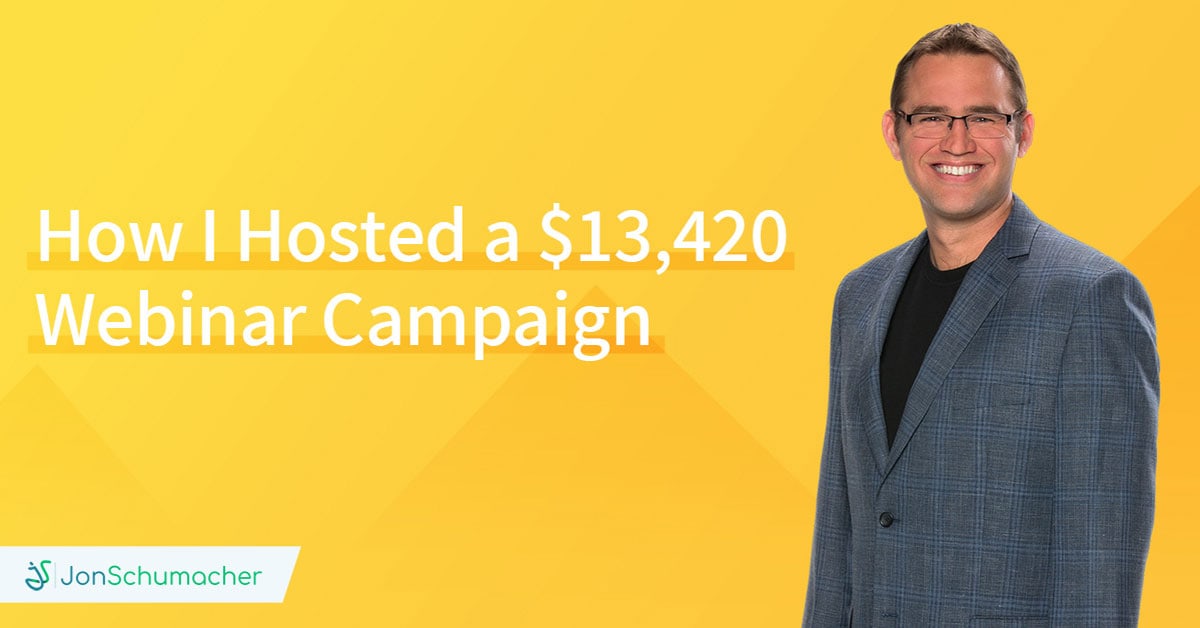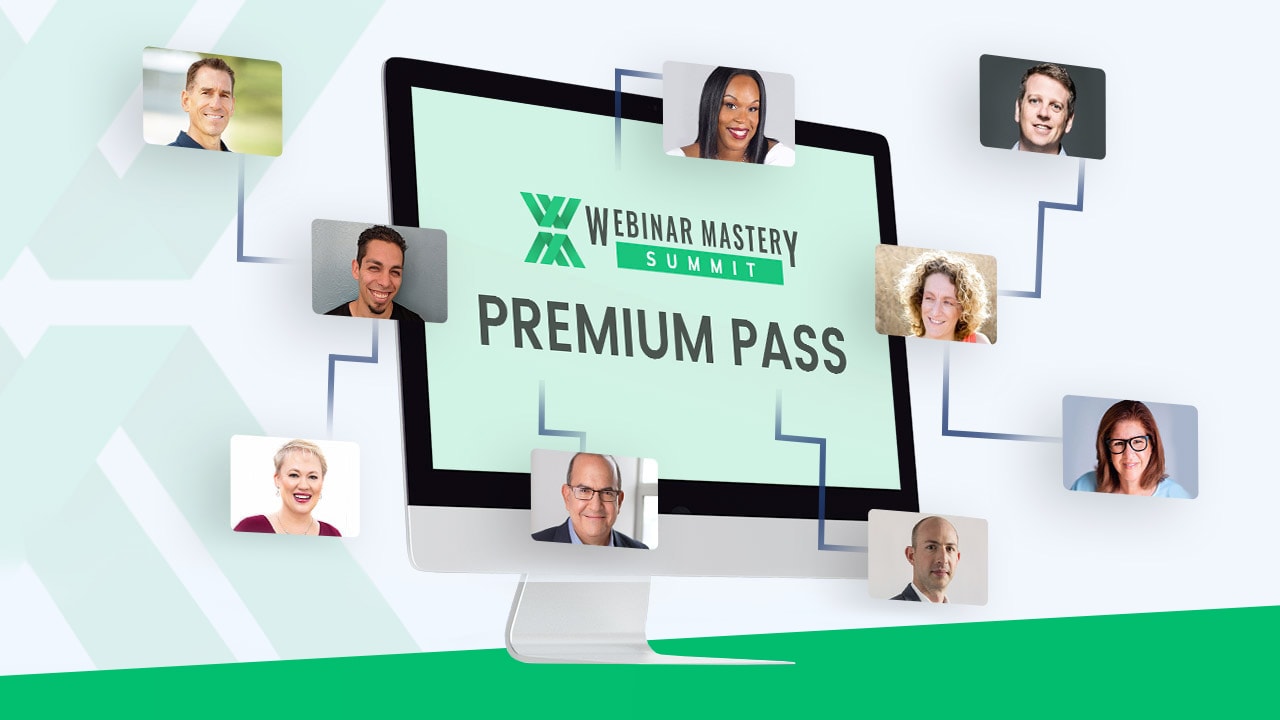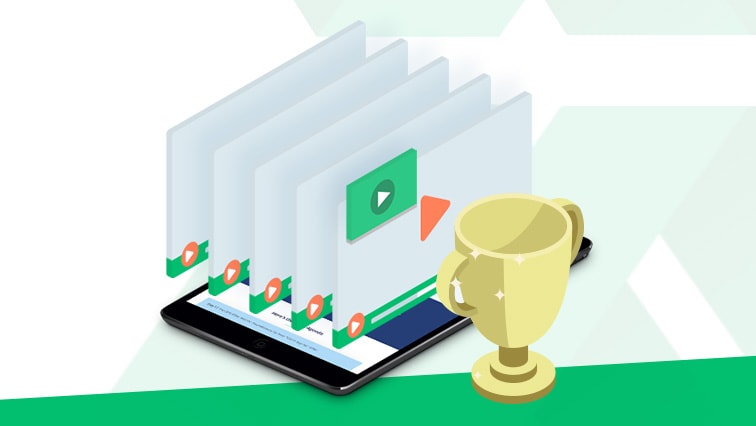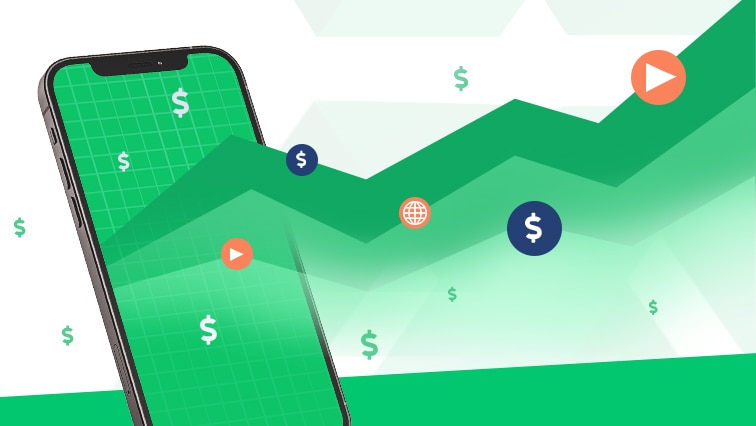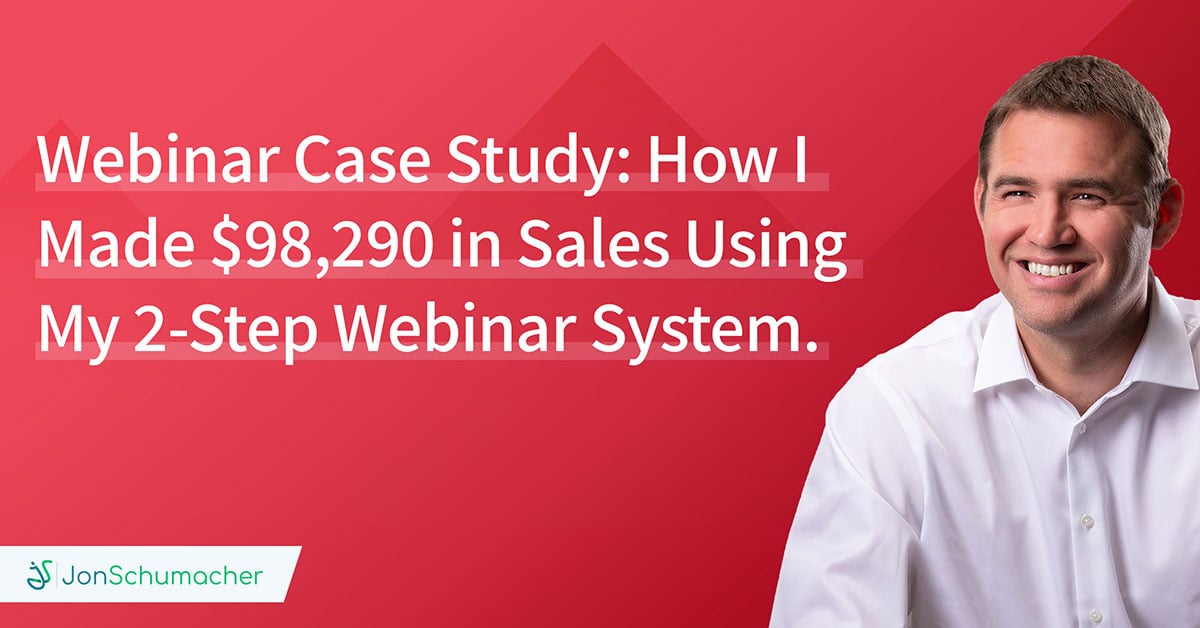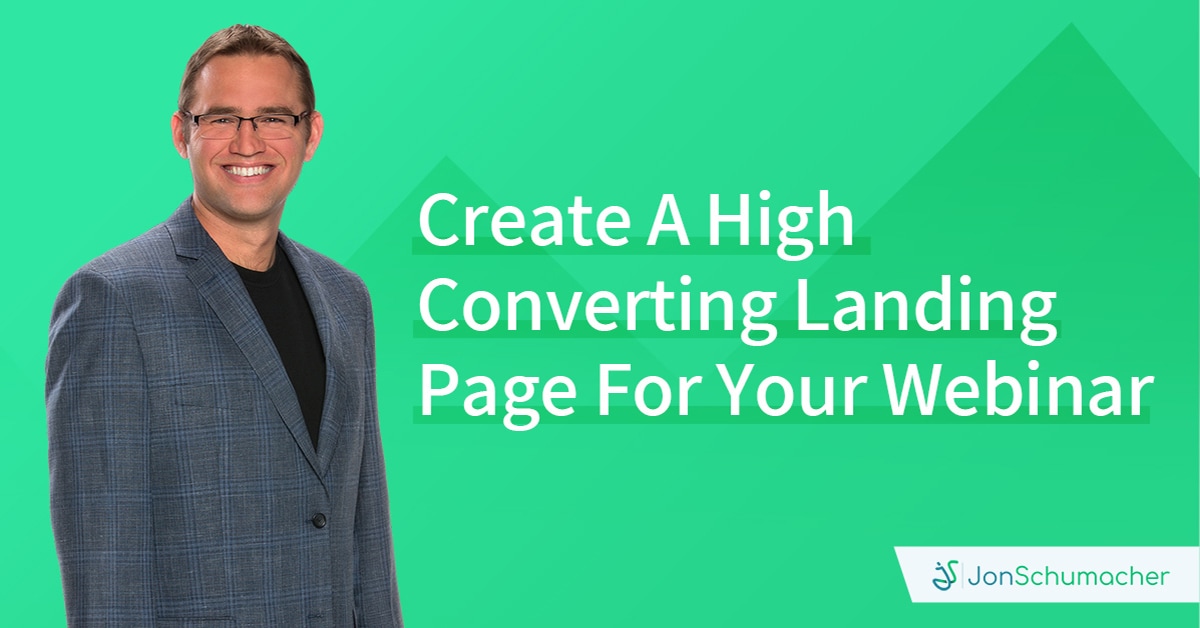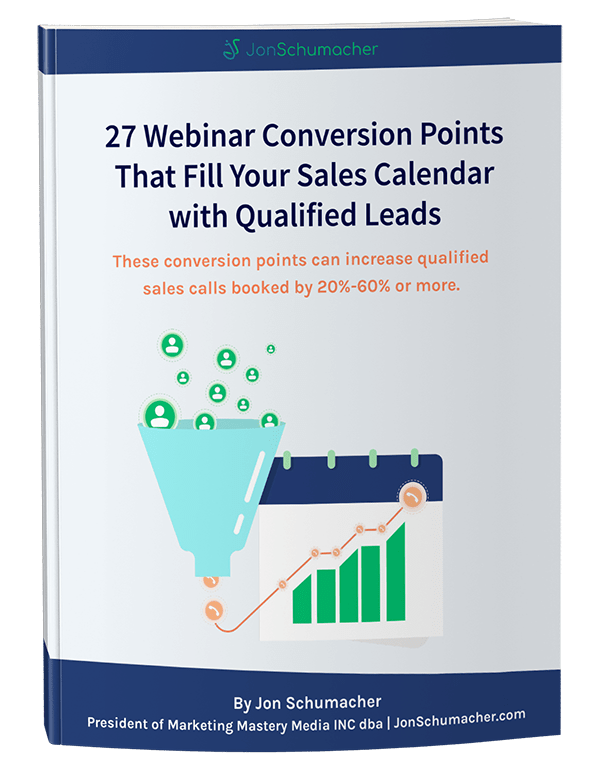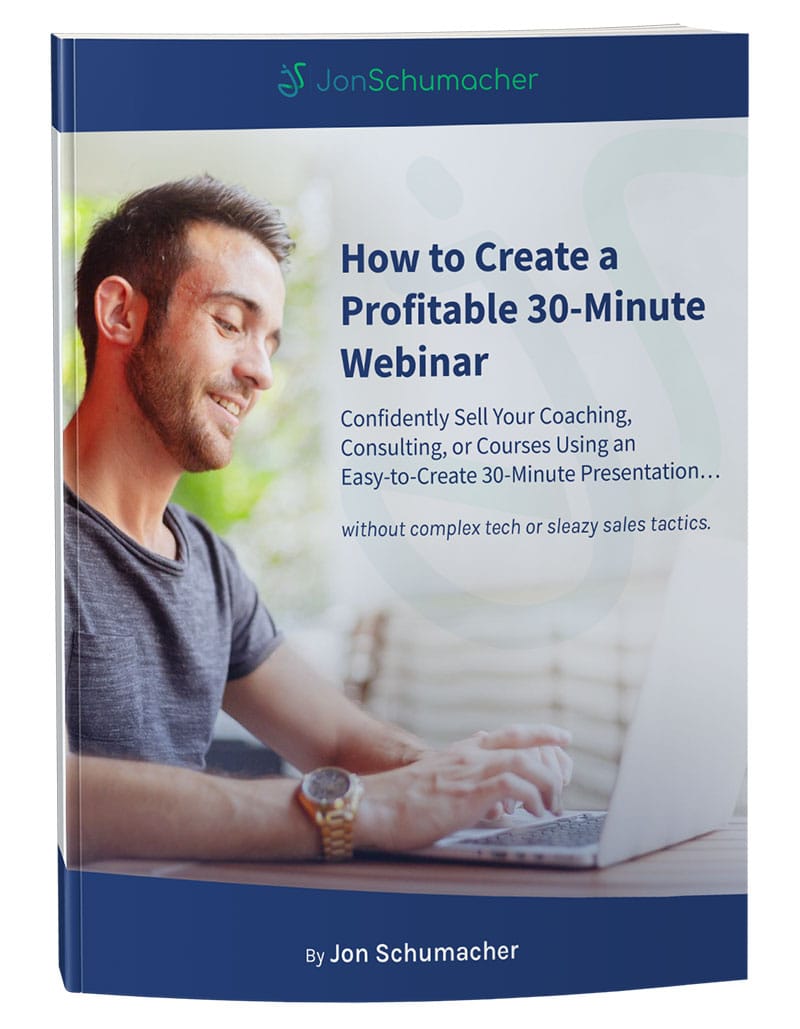Are you struggling to get more sales during your webinars?
In this case study, I break down the key components to a recent webinar that brought in $13,420.
I will be going through the entire webinar campaign from a pre-webinar, live webinar, and post-webinar perspective. I will also run you through the exact metrics, explain what they mean, and why they are so important. Let’s begin.
Main Objective of the Webinar
The main objective of this webinar was to sell access to a new group coaching program, the Webinar Mastery Academy, a 5-week group training program for newbie webinar hosts. The price point was $997 in full or 3 payments of $399.
Michael and I had just completed our Webinar Mastery Summit and wanted to offer our new subscribers an opportunity to implement what they had learned during the summit.
Pre-Webinar Phase
First, let’s go through the tools I used and how I got traffic to the webinar.
I used Webinar Jam Studio for our webinar software. I love the software for its live interface, native chat function, segmentation and tagging features, and analytics.
My email responder was ActiveCampaign with segmentation based on three webinar attendee behaviors: Signed up but didn’t attend, attended but didn’t buy, and bought live on the webinar. Each of these behaviors got a different email follow-up sequence.
For my shopping cart, I used SamCart and integrated it with Stripe and PayPal. We offered both full pay and 3-pay on the checkout page.
For my traffic source, I used our existing list of new subscribers from the summit and parts of our original email list. I ran no paid traffic, so our traffic costs were zero.
The Webinar was on a Tuesday. I started email promotion to drive webinar sign-ups as follows:
- Friday: Email 1
- Saturday: Resend Email 1 Only to Unopens
- Sunday: Email 2
- Monday: Email 3
- Tuesday: Email 4 plus a Last-Minute Email sent 15 minutes before the webinar started
I have found that email promotion starting 5 days prior to a 2-part pre-webinar email sequence works well for getting good sign-up and show-up rates.
A full breakdown of my sign-up numbers is available at the bottom of this post.
How I Got a 48% Show-up Rate
Industry standards for those who register but actually show up for your webinar are around 30%. Since you will make more sales when you get more people to attend live, improving your show-up rate is a key piece to a successful webinar campaign.
The following were a few ways I improved this webinar’s show-up rate:
- Sending a final promotional email 15 minutes before the webinar went live. This is one of the lowest hanging fruits for improving your show-up rate. I always get a 5% bump in our show-up rate when I do this.
- Having 5 different reminder notifications go out within the final 24 hours. People worry about sending too many reminders, but I have found that hardly anyone complains or unsubscribes because they are simply being reminded of something and not being sold. Reminders for this webinar went out at 24 hours, 6 hours, 3 hours, 1 hour, and 15 minutes prior to the webinar.
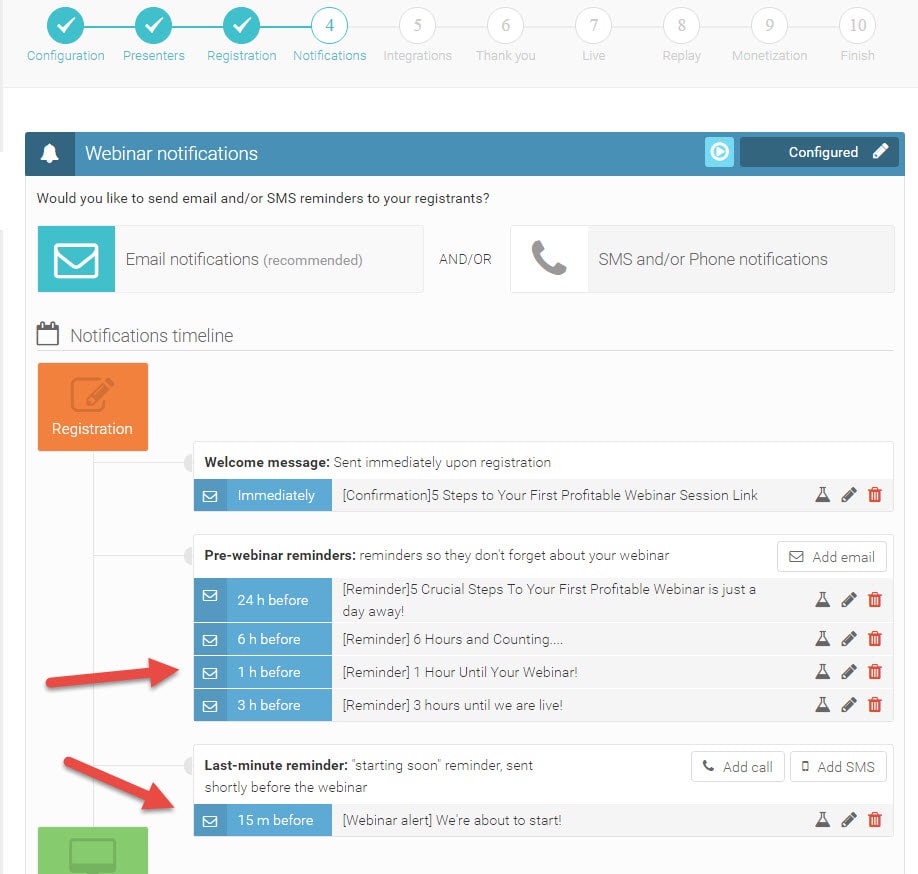
- Sending out pre-marketing emails after people register. I sent out a welcome email reminding them of the benefits of the webinar. I also included a blog post telling them “why” what they are going to learn is going to be important to them. The second email shared a brief case study and a video of some webinar technology tips.
- Optimizing the thank you page. Right after people sign up is the perfect time to start getting them to take micro-commitments and building excitement for the webinar. I used a short 5-minute video to remind them to add this webinar to their calendar now and to fill out the survey which was below the video. I also re-emphasized the big promise of the webinar and did a bit of teaching on the spot. Getting people to take a survey or click a relevant link to a free guide are great ways to get people taking action and increases the likelihood of them showing up.

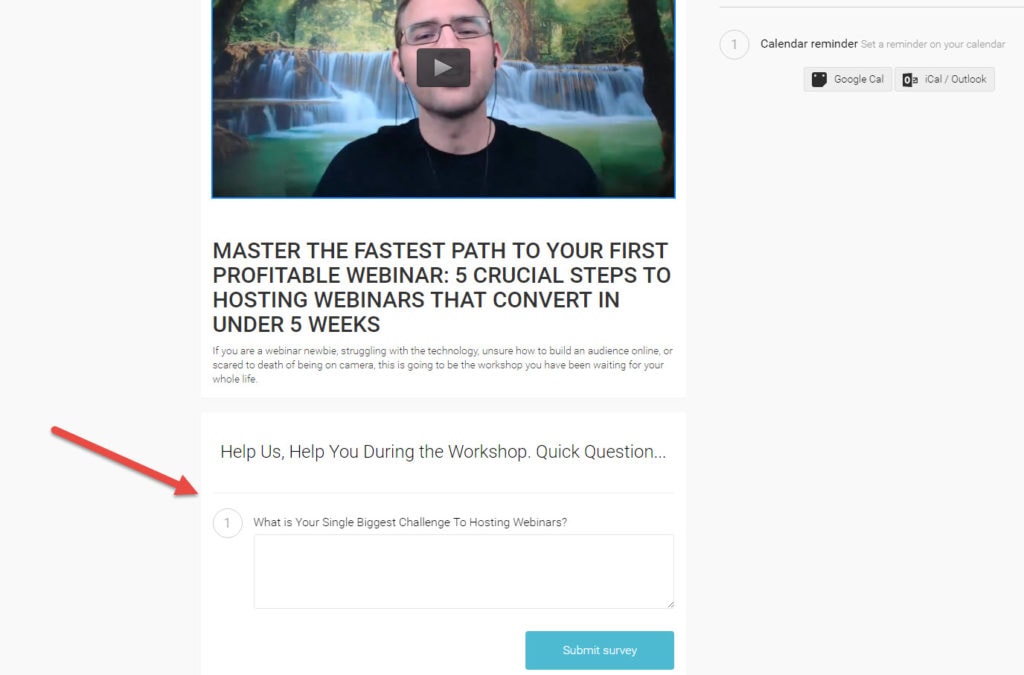
- Retargeting those who register on Facebook. Everyone who hit my thank you page was retargeted to the ad shown below. The ad campaign was set up for CPC vs CPM and the budget was $50/day. There was no CTA button or text on the ad, discouraging people from clicking. The goal of the ad was to get Facebook to share the ad frequently in the news feed of those who signed up reminding them of the webinar but not having them click the ad. When setting the ad for CPC, you are only charged per click and with the higher daily budget, the frequency of that ad was up, thus reminding would-be attendees often. The entire cost for this ad was only $23.
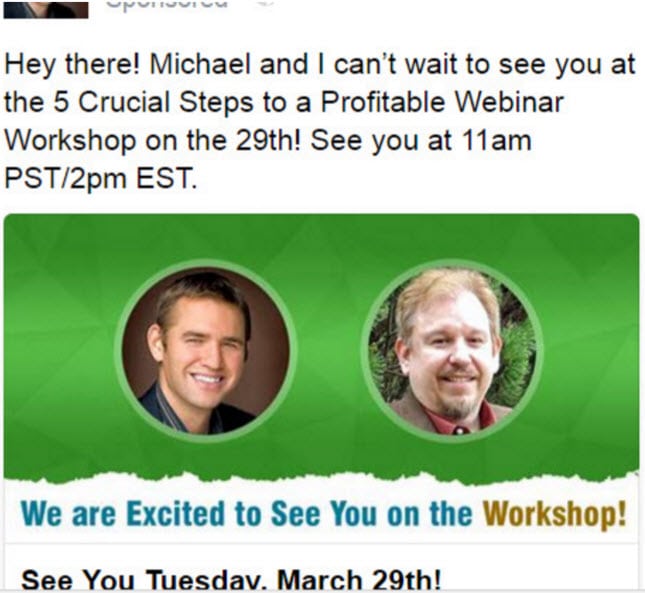
My friend Scott Oldford of Infinitus was one of the first to test and report on this Facebook technique.
Live Webinar Phase
Now I want to share the format I presented on the webinar. I also want to give some of my best tips for structuring a live webinar so it is straight forward and not hype, but also sells well.
The key to effectively and profitably running a sales webinar can be found in what I call, the 4-Step Selling System, which consists of the introduction, the content, the offer, and the Q&A.
Before you create your slides and structure your webinar, make a list of the following: The biggest pains your product or services solves (3-5) and the biggest objections people will have to buy your product. These pains and objections will be used to craft your webinar teaching points.
If you are selling an online course, what are the 3-5 main modules it offers, and what are the pains that each module solves? These will be your main content points. Teach lighter versions of your program so the content is congruent with your offer.
Introduction:
The key here is to build rapport, connect with your audience’s challenges, and share your expert story positioning. No one believes in your success until they have heard your struggle.
At the beginning of the webinar always remind people of the big promise, usually your headline. Tell them they are in the right place and show them what they are going to learn.
Share a few of their current pains. Then reveal how you can relate to those pains in the form of your expert story. Share your struggles, how you overcame those struggles with what you are teaching today, and what results you have had since.
Content:
This is the part everyone gets wrong and it costs them big time. Most of us are passionate experts and want to give so much to our audience. We turn on the fire hose and blast them in the face with everything we have ever learned.
While you want to teach some of the “How” and give away some of your best stuff, people tend to over teach the “How” and don’t hit the “Why” enough. Here’s the big one, they don’t remove the objections and fears that people have about their product or service.
Here was the structure of my content section:
- Start with a question for each content point. Make that question an objection that people commonly have about doing what you are selling. “Do I need to buy a bunch of expensive and complicated equipment to host webinars?” This is an example I used.
- Ask the audience to type their answer into the chat or have a slide with a multiple choice quiz and give them 30 seconds to answer. This gets the audience to engage with you.
- Break the belief and teach the main content point. Tell them why the objection is not true and share how they can overcome it. Give some of your best stuff. Make sure the content point is in line with the pains your offer solves.
- Use a story or case study to reinforce the content point. I find case studies of past clients work very well. I have had a number of customers who bought from me because they related to a person in one of my case studies. If you don’t have existing clients, use the stories of other successful people to illustrate the point.
Offer:
Now it is time to offer your product, service, software, or coaching program as a solution to get them the results you talked about in your content section much faster, without as much wasted time and money.
The transition from content to offer is one place where people tend to get nervous and mess up.
Make sure to “stretch the gap” for your audiences at this point. Stretching the gap means telling them something like the following…
“Today you have gotten a lot of actionable information, but knowledge is not enough. There is a gap between where you are now and where you want to be. There are going to be a number of specific challenges that can stop you from achieving your goals. You are still at point A and you want to get to point B.”
Make sure to remind them they are still stuck at point A and want to get to point B (which is the outcome they want from your offer).
Here are a few things I included in my offer section:
- I tied program features to benefits. One of the biggest mistakes we can make as marketers is to list a bunch of features of our program without strongly tying them to benefits. No one cares about having 8 new video modules to watch or 5 PDF guides. They want an outcome. Usually, the benefit of the benefit is one of the following: health, wealth, and/or happiness. List the features of your program, because people want to know what they are getting but tie them strongly to the benefit or pain that feature solves.
- I had bonuses that fill in the gaps. When selling information or coaching, it is a good idea to sell additional bonus services that fill in the gaps. I was selling a webinar course and know that technology is a big barrier for new hosts. As a bonus to the program, I made sure to include a technology guide in PDF format and a Tech Tuesday bonus section.
- I had a strong guarantee…In 5 Weeks, You Will Have Your First Professional, Sales-Generating Webinar Up And Running…Even If You’ve Failed Before…Or Your Money Back. I offered 60-day money-back guarantee that ran the length of the program. This meant that people could go through the course. If they loved it, they could keep it. If they didn’t they could have their money back. No risk to them.
- I used case studies to answer the question, “Will this work for me?” One of the biggest questions in your prospective customer’s minds is, will this work for me? You can remove that as an objection by showing case studies of past clients or others in your industry who have had results doing what you are offering.
Q&A:
During the Q&A section, I always plan to stay on as long as I can. There will obviously be drop off at this point but the longer you can get people to stay on with you the more likely they are to buy.
I used the Q&A section as a chance to answer questions about webinars and also the program. I pointed back to the program as a solution for all questions that were relevant. 60% of my live webinar sales came during the Q&A so don’t skip it.
Post-Webinar Phase
This is where the magic often is for most of my webinar campaigns. If done correctly, you can usually double your webinar sales.
For this webinar, I segmented my webinar attendees into three groups. One for those who signed up but didn’t attend. One for those who attended but didn’t buy. One for those who bought live on the webinar.
I used Webinar Jam Studio to pass tags to ActiveCampaign. Once those tags were added, email automations were sent out based on which of those three categories people fell into.
I was able to add another $4,885 in revenue on the backend of the webinar through email. There was a 6 day follow up sequence for those who attended but did not buy.
Here was my email follow-up sequence for attendees who didn’t buy:
- Email 1 29th PM: Takeaways- Reviewing the 5 steps + Why Webinars (my article)
- Email 2 30th: Why Most Webinar Trainings Will Fail You and Why This is Different
- Email 3 31st: Case For/Case Against
- Email 4 1st: Case Studies
- Email 5 2nd: FAQ/Objections
- Email 6 3rd: 24 hours until close
- Email 7: 12 hours until close
- Email 8: 6 hours
- Email 9: 3 hours
- Email 10: 1 hour
For those who missed the webinar, they were sent a replay sequence similar to the one above with slight variations towards the replay. Those who bought live were sent a 2 email onboarding sequence to gain access to the member’s area and Facebook group.
Numbers Breakdown and Explanation
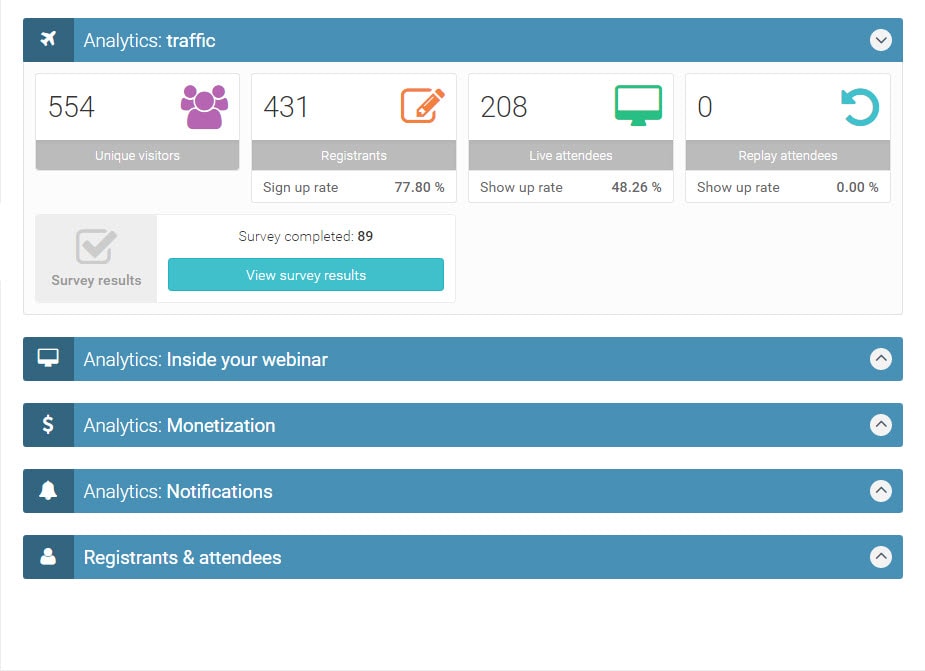
Traffic Source: My internal email list. No paid traffic was used.
Sign-up and Show-up Stats:
Email Traffic Source: 4,322 emails
Visitors to Reg page: 585
Sign-ups: 432
Sign-up Rate: 73.85%
Show-ups: 208
Show-up Rate: 48.15%
Industry standards for sign-up rates are around 50% and show-up rates around 30%. As you can see, I was significantly higher than those.
Live Revenue Stats:
Revenue Live: $5,385
Value Per Attendee Live (VPA) $25.89
The most important number to note is Value Per Attendee (VPA). If you know your VPA, you can feel comfortable spending a certain amount on paid ads to get people to attend. In this case, I could spend $25 to get someone live on my webinar and breakeven.
Total Revenue Stats:
Total Revenue to Date: $13,420
Value Per Registration: $31.07
Again, the Value Per Registration is the key metric. This was the total revenue to date from the live webinar, the email follow-up, and any other clients I got from the webinar. In this case, I could spend up to $31 to breakeven. I got another $4,885 in revenue from the email follow-up and another $3,150 from a private client I got as a result of the webinar.
Engagement Stats:
Attendance Graph: 5-minute mark: 113, 55-minute mark (offer) 160
Drop off Rate Average 0-60 minute: 2%
Offer Shown: 55-minute mark
Average Live Room Time: 1 hour 21 minutes
My engagement metrics were outstanding for this webinar. My attendance actually kept growing all the way up to the offer at the 55-minute mark. Drop off averaged only 2% and the average time in the live room was well past the offer. This tells me I did a good job of providing well-paced content and using audience engagement techniques like polls, quizzes, and case studies to keep people on.

